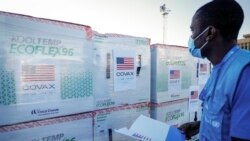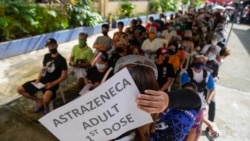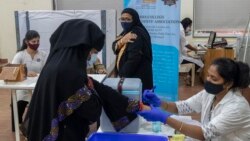The discovery of the Omicron version of the coronavirus is demonstrating the risks linked to world vaccine inequality.
South African scientists informed the World Health Organization (WHO) last week about the new Omicron version, or variant.
The WHO has declared Omicron a “very high” risk worldwide because it contains some “concerning” mutations. A mutation is a change in the genetic material of a virus. Early evidence suggests the new variant may spread more easily than other coronavirus versions.
Many countries have closed their borders in an attempt to block new infections of the variant. The United States, Brazil, Britain and the European Union have placed travel restrictions on eight African nations where the variant was first identified.
Health experts say Omicron is an example of how low vaccination rates in some parts of the world can result in new variants being created that can end up threatening numerous countries.
The clearest example of vaccine inequality is Africa, where the new variant was discovered. Across the continent, less than 7 percent of the population is vaccinated.
The WHO-supported COVAX vaccine program was supposed to prevent such inequality. The program aims to bring together international organizations to develop, produce and deploy COVID-19 vaccines to nations that most need them.
But COVAX has struggled to reach its vaccine targets. It has already given up on its goal to provide 2 billion vaccine doses.
To reach its new target of providing 1.4 billion doses by the end of this year, COVAX would need to ship more than 25 million doses every day. But an examination by the Associated Press finds that the organization has shipped an average of just 4 million doses a day since the beginning of October.
Data from the International Monetary Fund, IMF, suggests that just 13 percent of vaccines COVAX contracted for have actually been delivered. In addition, only 12 percent of promised donations have yet been delivered.
Wealthier nations, on the other hand, are enjoying a flood of vaccine supplies. More than 60 nations are now offering booster doses to already fully vaccinated individuals. The WHO has urged nations against providing booster shots when so many countries are dealing with massive populations of unvaccinated people.
Dr. Osman Dar directs the One Health Project at the Chatham House international policy center in Britain. He told the AP the Omicron variant demonstrates “the continuing and fundamental risks” that grew out of failures to effectively deal with vaccine inequality.
Health experts say the difficulties are not limited to just getting the vaccines into poorer countries. COVAX is also “falling short on getting vaccines from the (airport) into people’s arms,” said Dr. Angela Wakhweya. She is with the humanitarian aid organization CARE.
In one example last summer, officials in Congo returned their whole COVAX shipment when they realized they would not be able to give the shots before the safety date of the vaccines ended.
U.S. Secretary of State Antony Blinken said Tuesday he agrees that part of the problem has been a lack of resources in some nations to actually get vaccine injections into arms.
Speaking in Latvia while attending a meeting of NATO foreign ministers, Blinken noted that “a real disparity” exists between vaccinations in Africa and the United States and Europe.
The U.S. -- which blocked vaccine sales overseas and exports of vaccine ingredients for months -- has now donated 275 million doses in all. This is more than any other country. But most of the U.S. administration's promise to provide 1.1 billion doses has a deadline of September 2022.
The European Union -- which has generally permitted vaccines manufactured in the EU to be sold anywhere in the world -- has delivered about a third of its 500 million promised doses.
I’m Bryan Lynn.
The Associated Press reported on this story. Bryan Lynn adapted the report for VOA Learning English. Caty Weaver was the editor.
We want to hear from you. Write to us in the Comments section, and visit our Facebook page.
__________________________________________________
Words in This Story
dose – n. the amount of a medicine, drug or vitamin that is taken at one time
deliver – v. to transport something from one place to another
booster – n. an extra amount of a substance (called a vaccine) that is injected with a needle into a person or animal to help protect against a disease
fundamental – adj. relating to the most important or main part of something
disparity – n. a difference, usually related to the amount of money people earn or their position
ingredient – n. one of the things that are used to make a food, product, etc.
deadline – n. a time by which something must be done











